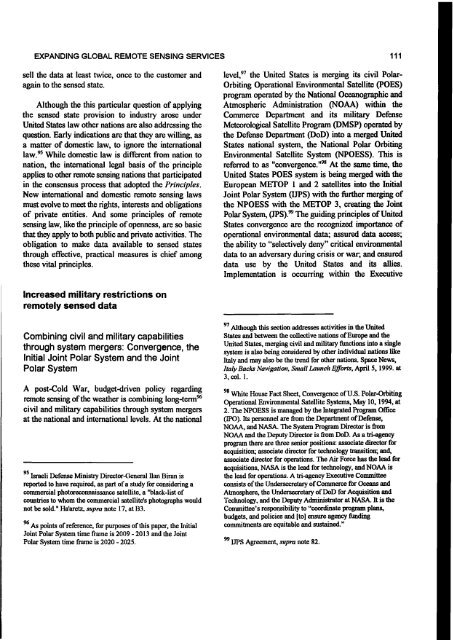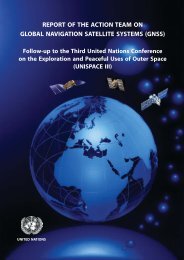Proceedings of the Workshop - United Nations Office for Outer ...
Proceedings of the Workshop - United Nations Office for Outer ...
Proceedings of the Workshop - United Nations Office for Outer ...
- No tags were found...
Create successful ePaper yourself
Turn your PDF publications into a flip-book with our unique Google optimized e-Paper software.
EXPANDING GLOBAL REMOTE SENSING SERVICES 111sell <strong>the</strong> data at least twice, once to <strong>the</strong> customer andagain to <strong>the</strong> sensed state.Although <strong>the</strong> this particular question <strong>of</strong> applying<strong>the</strong> sensed state provision to industry arose under<strong>United</strong> States law o<strong>the</strong>r nations are also addressing <strong>the</strong>question. Early indications are that <strong>the</strong>y are willing, asa matter <strong>of</strong> domestic law, to ignore <strong>the</strong> internationallaw.95 While domestic law is different from nation tonation, <strong>the</strong> international legal basis <strong>of</strong> <strong>the</strong> principleapplies to o<strong>the</strong>r remote sensing nations that participatedin <strong>the</strong> consensus process that adopted <strong>the</strong> Principles.New international and domestic remote sensing lawsmust evolve to meet <strong>the</strong> rights, interests and obligations<strong>of</strong> private entities. And some principles <strong>of</strong> remotesensing law, like <strong>the</strong> principle <strong>of</strong> openness, are so basicthat <strong>the</strong>y apply to both public and private activities. Theobligation to make data available to sensed statesthrough effective, practical measures is chief among<strong>the</strong>se vital principles.level,97 <strong>the</strong> <strong>United</strong> States is merging its civil Polar-Orbiting Operational Environmental Satellite (POES)program operated by <strong>the</strong> National Oceanographic andAtmospheric Administration (NOAA) within <strong>the</strong>Commerce Department and its military DefenseMeteorological Satellite Program (DMSP) operated by<strong>the</strong> Defense Department (DoD) into a merged <strong>United</strong>States national system, <strong>the</strong> National Polar OrbitingEnvironmental Satellite System (NPOESS). This isreferred to as "convergence."98 At <strong>the</strong> same time, <strong>the</strong><strong>United</strong> States POES system is being merged with <strong>the</strong>European METOP 1 and 2 satellites into <strong>the</strong> InitialJoint Polar System (IJPS) with <strong>the</strong> fur<strong>the</strong>r merging <strong>of</strong><strong>the</strong> NPOESS with <strong>the</strong> METOP 3, creating <strong>the</strong> JointPolar System, (JPS).99 The guiding principles <strong>of</strong> <strong>United</strong>States convergence are <strong>the</strong> recognized importance <strong>of</strong>operational environmental data; assured data access;<strong>the</strong> ability to “selectively deny” critical environmentaldata to an adversary during crisis or war; and ensureddata use by <strong>the</strong> <strong>United</strong> States and its allies.Implementation is occurring within <strong>the</strong> ExecutiveIncreased military restrictions onremotely sensed dataCombining civil and military capabilitiesthrough system mergers: Convergence, <strong>the</strong>Initial Joint Polar System and <strong>the</strong> JointPolar SystemA post-Cdd War, budget-driven policy regardingremote sensing <strong>of</strong> <strong>the</strong> wea<strong>the</strong>r is combining long-term96civil and military capabilities through system mergersat <strong>the</strong> national and international levels. At <strong>the</strong> national9 5Israeli Defense Ministry Director-General Ilan Biran isreported to have required, as part <strong>of</strong> a study <strong>for</strong> considering acommercial photoreconnaissance satellite, a "black-list <strong>of</strong>countries to whom <strong>the</strong> commercial satellite's photographs wouldnot be sold." Ha'aretz, supra note 17, at B3.96 As points <strong>of</strong> reference, <strong>for</strong> purposes <strong>of</strong> this paper, <strong>the</strong> InitialJoint Polar System time frame is 2009 - 2013 and <strong>the</strong> JointPolar System time frame is 2020 - 2025.97 Although this section addresses activities in <strong>the</strong> <strong>United</strong>States and between <strong>the</strong> collective nations <strong>of</strong> Europe and <strong>the</strong><strong>United</strong> States, merging civil and military functions into a singlesystem is also being considered by o<strong>the</strong>r individual nations likeItaly and may also be <strong>the</strong> trend <strong>for</strong> o<strong>the</strong>r nations. Space News,Italy Backs Navigation, Small Launch Ef<strong>for</strong>ts, April 5, 1999. at3, col. 1.98 White House Fact Sheet, Convergence <strong>of</strong> U.S. Polar-OrbitingOperational Environmental Satellite Systems, May 10,1994, at2. The NPOESS is managed by <strong>the</strong> Integrated Program <strong>Office</strong>(IPO). Its personnel are from <strong>the</strong> Department <strong>of</strong> Defense,NOAA, and NASA. The System Program Director is fromNOAA and <strong>the</strong> Deputy Director is from DoD. As a tri-agencyprogram <strong>the</strong>re are three senior positions: associate director <strong>for</strong>acquisition; associate director <strong>for</strong> technology transition; and,associate director <strong>for</strong> operations. The Air Force has <strong>the</strong> lead <strong>for</strong>acquisitions, NASA is <strong>the</strong> lead <strong>for</strong> technology, and NOAA is<strong>the</strong> lead <strong>for</strong> operations. A tri-agency Executive Committeeconsists <strong>of</strong> <strong>the</strong> Undersecretary <strong>of</strong> Commerce <strong>for</strong> Oceans andAtmosphere, <strong>the</strong> Undersecretary <strong>of</strong> DoD <strong>for</strong> Acquisition andTechnology, and <strong>the</strong> Deputy Administrator at NASA. It is <strong>the</strong>Committee’s responsibility to “coordinate program plans,budgets, and policies and [to] ensure agency fundingcommitments are equitable and sustained.”99 UPS Agreement, supra note 82.
















